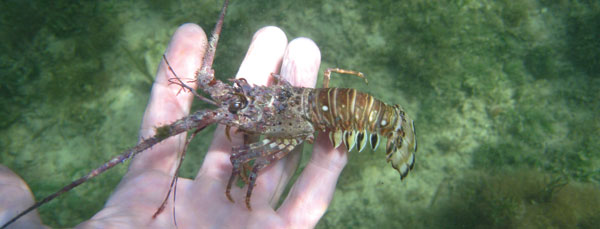Extracts

UF Researches Virus Threatening Lobsters
Tom Nordlie
The Caribbean spiny lobster is one of Florida’s top commercial seafood species, with an annual $27 million harvest — but a recently discovered virus is killing the crustaceans and threatening the industry.
Now, scientists with the University of Florida and several other institutions have been awarded a three-year, $1.4 million National Science Foundation grant to research transmission of the virus, known as PaV1.
The research should answer many lingering questions about the spread and geographic distribution of the pathogen, and could lead to management strategies and new methods for identifying infected lobsters, said Don Behringer, an assistant professor with UF’s Institute of Food and Agricultural Sciences.
One of the main issues to be investigated: whether the virus is dispersed long distances by lobster larvae, which float hundreds of miles during their first months. Infected spiny lobsters have been found in far-flung places, including the Florida Keys and parts of Mexico, Belize and St. Croix.
“This project will give us insight into how pathogens are spread in the marine environment,” said Behringer, a co-discoverer of the virus. “Anything we can do to understand how the disease spreads, and how we might limit its spread, has implications for management of the disease.”
If the study confirms that PaV1 is spread by lobster larvae, that would have implications for other species and other diseases, because many marine animals go through a free-floating larval stage, said Mark Butler, a professor with Old Dominion University in Norfolk, Va.
During the project, researchers will examine possible forms of virus transmission, the virus’ effects on lobsters, and factors influencing local disease outbreaks, Butler said. They will also hold workshops for fishermen and resource managers in Florida and the Caribbean.
The virus was discovered in 1999 by Behringer, Butler and Jeffrey Shields with the Virginia Institute of Marine Science. Many of the early findings regarding PaV1 epidemiology came while the team was working at the Keys Marine Laboratory located on Long Key. This work showed that the disease primarily kills juvenile spiny lobsters, though some become infected without apparent harm.
The PaV1 virus attacks blood cells and tissues, causing lobsters to become listless and solitary, Behringer said. Most eventually die from metabolic depletion, a condition characterized by loss of energy.
Beginning with the 2000-2001 lobster season, harvest declined approximately 30 percent from previous harvest years and has yet to rebound, said John Hunt, a longtime lobster biologist and program manager with the Florida Fish and Wildlife Conservation Commission.
Hunt said he believes the virus is a likely cause of the reduction.
Florida produces more than 90 percent of the nation’s spiny lobster; in 2007 the harvest was about 3.8 million pounds, with a dockside value of $27 million, according to the Florida Department of Agriculture and Consumer Services. Recreational lobster diving is also a significant tourist industry.
The Caribbean spiny lobster is found in the Gulf of Mexico, Caribbean Sea and western Atlantic Ocean, from Bermuda to Brazil, Behringer said.